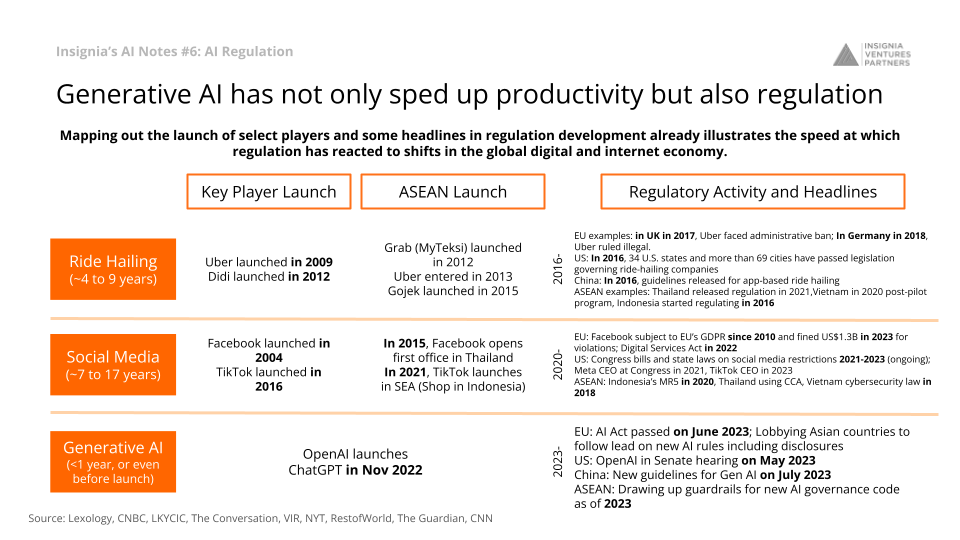Last Saturday, Shefali Dodani from our investment team joined Matthew Windsor, VP of Investments at Openspace and Benjamin Cisteky, Director of AI Investments at Temasek for a discussion at the KBTG (Kasikorn Business Technology Group)’s “Techtopia: Across the AI-Verse” conference in Bangkok.
The panel focused on venture capital investment trends in AI, especially with generative AI technologies presenting a step change expansion in the potential use cases for AI.
What are these use cases? Follow our AI Notes series as we tackle gen AI use cases in verticals like fintech and healthcare, as well as the rise of LLM-driven autonomous AI agents.
In these panel notes, Shefali shares four key insights on how LLMs and generative AI are impacting venture capital opportunities and venture-backed growth for tech companies.
Impact #1: OpenAI has catalyzed “gold mine” formation for AI startups, but accuracy remains a key technological investment risk
Microsoft’s US$13B investment in Open AI has undoubtedly given birth to a new wave of startups within the artificial intelligence sector.
More investors have begun looking at artifical intelligence even in emerging market regions like Southeast Asia where SaaS adoption remains low. In 2021, investors invested a total of US$109B in AI startups, which represented a 2.0x increase from the previous year. However, this normalized down to US$70B in 2022.
Then with the launch of Open AI, the investment size for seed to growth stage increased significantly, doubling from 2019 to 2023 from a low US$1.6M seed investment to US$3.2M today.
Investors have undeniable interest in AI today, populating a gold mine for startups carved out by OpenAI. ChatGPT only took 5 days to reach a million users, while Facebook took 10 months. In contrast, just within 9 months, Midjourney, a text to image startup managed to secure 18 million users.
At the same time, from an investment perspective, we are seeing more artificial intelligence companies built on Open AI in industries with higher margin of error, such as the creative industry.
Insignia Business Review tackles other risks and how regulators have been reacting in this article in our AI Notes series.
Impact #2: Increased ability for companies to learn with context sets up competitive dimension along which companies have access to the best infrastructure
As we see an increase in adoption for vertical commerce in the region, we will see AI investments made with business models built for specific verticals. For example, previously AI models were built for solutions that needed no context, such as bots with auto-responses or OCR technology. However, with AI technologies inching closer in the direction of artificial general intelligence, companies can now build proprietary engines to learn with context.
In fintech, we foresee an emergence of companies that build out new risk model frameworks that use not only governmental databases for data inputs but use alternative data-sources to learn, such as historical payment behaivour, social media amongst other factors. There will be an emergence in infrastructure models built on AI for specific industries.
On the On Call with Insignia podcast, Dino Setiawan, CEO of supply chain financing company AwanTunai, talks about how they’ve leveraged proprietary ERP software to power their own risk engine (which has attracted data science talent globally) and underwrite what has traditionally been an underbanked segment of Indonesia’s economy.
Impact #3: When it comes to sales growth, gen AI can bridge the gap between scale and customization with self-serve products
One of our portfolio companies, WIZ.AI, is a conversational voice AI solution available across 17 countries. What is interesting about this company is how it evolved from a text to speech company leveraging NLP to an one that can provide dynamic calls that are more personalized to a client’s customers with the help of Open AI.
The key learning from WIZ.AI’s evolution is that while product is important, companies need to be careful with their sales segmentation and strategy. Serving enterprise clients may mean large contracts, but this should not come at the expense of time spent on customization. If you are able to sell a self-serve model to a lower sales cycle with a great product, you have a high-growth company.
And this self-serve model will likely be the model of the future as the productization of AI matures. As Jennifer Zhang, CEO of WIZ.AI, once put it in the On Call with Insignia podcast: “…productization is going towards…how you can enable, through your platform, your user to be more self-serving…You don’t need to actually reinvent the wheel. Then if the platform and interface are user-friendly enough, then once you go hand-in-hand wit them, teach them one or two use cases, then they will actually build by themselves. I think all SaaS companies will become platform ecosystems, to invite more people to create things.”
Impact #4: GPU component of AI startups adds additional layer of due diligence and portfolio services for VCs
In this part of the world, startup investment terms are more vanilla. But as of late, we (Insignia Ventures) have been discussing internally about implementing clauses that govern the use of GPUs. Given that AI companies raise significant amounts of funding in the early days, this would be key for us to have an oversight on.
Additionally, in SEA a lot of VCs already offer access to AWS credits, including us. These perks may extend to GPUs in the near future, given that access to GPUs is not only expensive but limited. If so, this will be a massive leap and a key consideration for startups on which term sheets to accept, other than just the standard round dilution and valuation.
Even with these changes, some principles remain important
Even as generative AI is reshaping key aspects of how venture-backed startups grow and venture funds invest, some first principles remain as important as ever in the early stages of growth. For instance, it is better to be picky on the partners you bring to your cap table and board, than to be picky on valuation. This is especially important for companies built on AI, where the product and technology risk is far higher earlier on than your traditional internet platform or marketplace.
If you want to continue this conversation on AI with Shefali, you can reach out to her on LinkedIn or via email.
Shefali Dodani is part of the Investment Team at Insignia Ventures Partners, joining the firm from the Director’s Office at Shopee where she worked on special projects and co-led Shopee Video. Before that, she was an Investment associate at Indonesian venture capital firm Skystar Capital for three years, where she led the investment evaluation and closing for startups across various sectors including Fuse, ESB, Wallex and many others. She graduated from the University of Hong Kong with a Bachelor’s Degree in Business Administration, Accounting and Finance.

